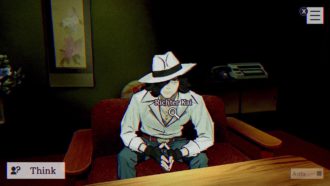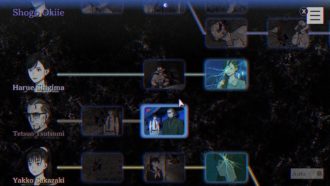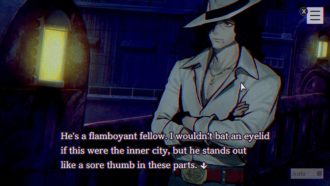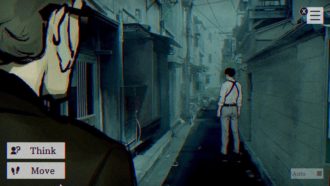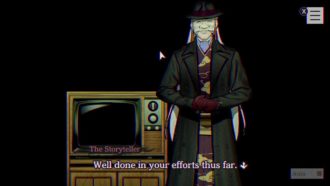Platforms:
PC, Nintendo Switch
Released:
March 8, 2023
Publisher:
Square Enix
Developer:
Square Enix
PARANORMASIGHT: The Seven Mysteries of Honjo is a visual novel wrapped around the occult, murder mysteries and layers upon layers of intrigue. It’s set in Honjo, Tokyo’s Sumira Ward in the Showa period of 1926-1989. It’s one of many recent atypical and experimental projects developed and published by Square Enix. Filled with inventive gameplay for the genre along with surprises and scares at many a turn, it’s the best of the bunch yet.
The occult, mysterious suicides and a story like no other
Legend has it that the story of The Seven Wonders of Honjo (art and folklore tales long adapted in various means in Japan) has taken the form of curses. On one fateful night, Honjo locals have a curse stone happen upon them. This marks them as the curse bearer. These curse stones come with ghostly manifestations of each of the Seven Wonders but also are used to kill people, resulting in deaths of a similar fate to that of the characters in the Wonders. Not an object you can immediately discard (it’s later revealed it ends up right back in the curse bearer’s hands unless passed on to another curse bearer), the cast is but stuck with this stone. What becomes tantalising and the heart of the mystery of these curse stones and the paranormal that surrounds them is the promise of a reward. Kill with the stone and you gain ‘soul dregs.’ Collect enough of these dregs and one can engage in the Rite of Resurrection, a ritual that resurrects someone from the dead.
PARANORMASIGHT: The Seven Mysteries of Honjo follows quite a large cast of characters, each of them a curse bearer. Your journey begins with Shogo Okiie, an everyday young 20-something that agrees to investigate these stones with a new associate Yoko. That adventure quickly spirals and before long you’re railroaded into taking the story elsewhere, engaging in one of the other three playable characters. Those come in veteran detective Tetsuo Tetsumi, grieving mother Harue Shigima and schoolgirl Yakko Sakazaki.
What quickly becomes apparent with PARANORMASIGHT is that this is a game that’s an exercise of selfishness. Morals become blurred as each curse bearer, playable or otherwise, has their own motivations for reviving someone in their life. Harue for instance had her own son brutally kidnapped and later murdered. Grief-stricken and too far off the deep end, she’s but one figure that is blinded by this motivation. No other lives matter, only the love of a Mother and the life of a son. Meanwhile, you have Yakko, believing the recent suicide of her classmate isn’t all it seems and wants answers to bringing her back.
Across your journey throughout Honjo, you’ll even meet a university student whose sole motivation is to bring back the famous and influential Japanese artist Katsushika Hokusai. Could you imagine being the person that brought back the artist behind The Great Wave off Kanagawa? No wonder some are driven to such madness.

A lot of the encounters with other curse bearers are high in tension. To pull off a kill with one’s curse stone, conditions must be met. These look like only being able to attack those that have a light source on them (lighter, flashlight etc) or only being able to pounce when a foe turns their back to you. Yes, you can kill some opponents in the game to varying degrees of chaotic results. However, the other curse-bearer may be able to kill you if you don’t gauge what their condition is in time or fall into one of their traps. As often you yourself and your opponent don’t know what the other’s condition is, you’re skating around conversations ever so carefully in a battle of wits, hoping to outsmart the other. It’s brilliant.
To level out each character and bring them back down to Earth, they are exploring their own Honjo mysteries with a companion. Harue comes with a hired private investigator, helping to solve the cold case of her departed son. Detective Tsumitsi comes with a co-worker subordinate and so on. I found every single one of these dynamics to be entirely engaging and that’s thanks to the expert visual novel writing on offer. Harue tests the investigator by wanting to get her hands dirtied and bloodied, while he longs to play by the books and law. Tsumitsi’s partner Jun Erio may be a junior but brings liveliness to his tired superior.
“PARANORMASIGHT: The Seven Mysteries of Honjo brings a gigantic, sweeping story that never outstays its welcome.”
It’s worth noting that PARANORMASIGHT can be quite scary, but is never quite fully barreling down the road of horror. Ghosts and apparitions, at times looking to be inspired by the work of horror craftsman Junji Ito, will appear in jump-scares but fade away before you know it. This is an entirely stylistic story and world told where both every day late 20th Century Japan and the paranormal meet. Adding to that flavour is the mystique of the Storyteller, an old man that introduces the start of many chapters, standing alongside an old CRT television.
PARANORMASIGHT: The Seven Mysteries of Honjo brings a gigantic, sweeping story that never outstays its welcome. All its wild events somehow take place across an intense 24-hour period. Themes and questions raised such as deliberating on whether or not there is value to one life over another are tackled expertly. There are dozens of effective twists and reveals throughout that do well in keeping the player engaged. Better yet, the characters’ stories will collide, intertwine and meld in meaningful ways. What at first may appear as a random throwaway line of dialogue early on will later come back and become an important thread in unravelling the mystery. The body count will climb. Tensions will rise. The only moment to breathe in the tight, at times chilling story will come in its very conclusion.
Pulling at a mysterious thread and reworking the visual novel genre
If the aforementioned reference to the Storyteller character weren’t enough to tip you off, you’re in for quite the meta experience here. One of the big examples of this is the fact that information, clues and the likes you find in one character’s story may be beneficial in another. There are more than a handful of times when you’re faced with a puzzle that, unless you’ve played someone else’s prior, you cannot progress in that story. The game cleverly knows when to offer a suspend point for such moments, something that otherwise isn’t normally allowed as the game requires and encourages you to commit to a chapter you’ve started or else lose that progress. Entirely efficient, you’re then thrown to a story tree screen where you can clearly see where a story has or maybe will soon branch, and will have marked out those that have reached an end or suspension.
Getting into the meat and nature of these puzzles is tough without spoiling some of the coolest mechanical reveals and moments. Though a big clue to how to progress forward is often found in your files and the information you’ve gathered, reflected in a menu. Someone had a question for me that I didn’t have an answer to until I learnt relevant details in another person’s story. Once this was noted in my menus, I could go back to that crossroad I was stopped at and give them the required answer. This goes further and further. A late puzzle, for instance, stumped me entirely until I got to know some of the data entries that taught Japanese history intimately. You’re immensely rewarded the more you engage with PARANORMASIGHT’s world, and boy is it a joy to explore.
On top of this are more out-of-the-box puzzle solutions that feel very in the spirit of the Zero Escape series. Tweaking options and settings in the pause menu may seem just something you need to do at the start to optimise your experience, but actually became the solution to a puzzle or two in-game. Without a doubt, the most thrilling puzzle in-game came when a character was in a spot of bother and had to communicate with another character in their chapter by using a fax machine.
PARANORMASIGHT: The Seven Mysteries of Honjo is a 2D visual novel, but that comes with a twist. The ‘screens’ that you’re transported to between scenes can be explored a bit more by a 3D rotation of the camera. This means that the character is technically standing in place and the 2D image is moving and panning across, revealing secrets that may be behind you. It sounds hard to stomach but it works quite well and is a refreshing way of engaging with interactive points in a scene. It’s effective in immersing players in the scene too – maybe a crime scene will have clues behind where you first spawn. Most cruel but delightful is when it uses this mechanic as a jumpscare. Hearing a horrific noise behind you, knowing you have to slowly turn and be at the whim of whatever awaits is an excellent scare.
You’re provided with an excellent feeling of popping on that detective hat to solve the mysteries in-game. The puzzles that you face are never all too hard and will make you feel clever once you finally crack them. Reviewing the timeline of stories to occur is similarly engaging, and effective in encouraging players to run through every bad ending and route until they inevitably reach the final conclusion. The only time the feel-good investigative vibes let up in the slightest is that from time to time you will have to exhaust dialogue a little too much or click on every single interactable object in a scene before you can continue.
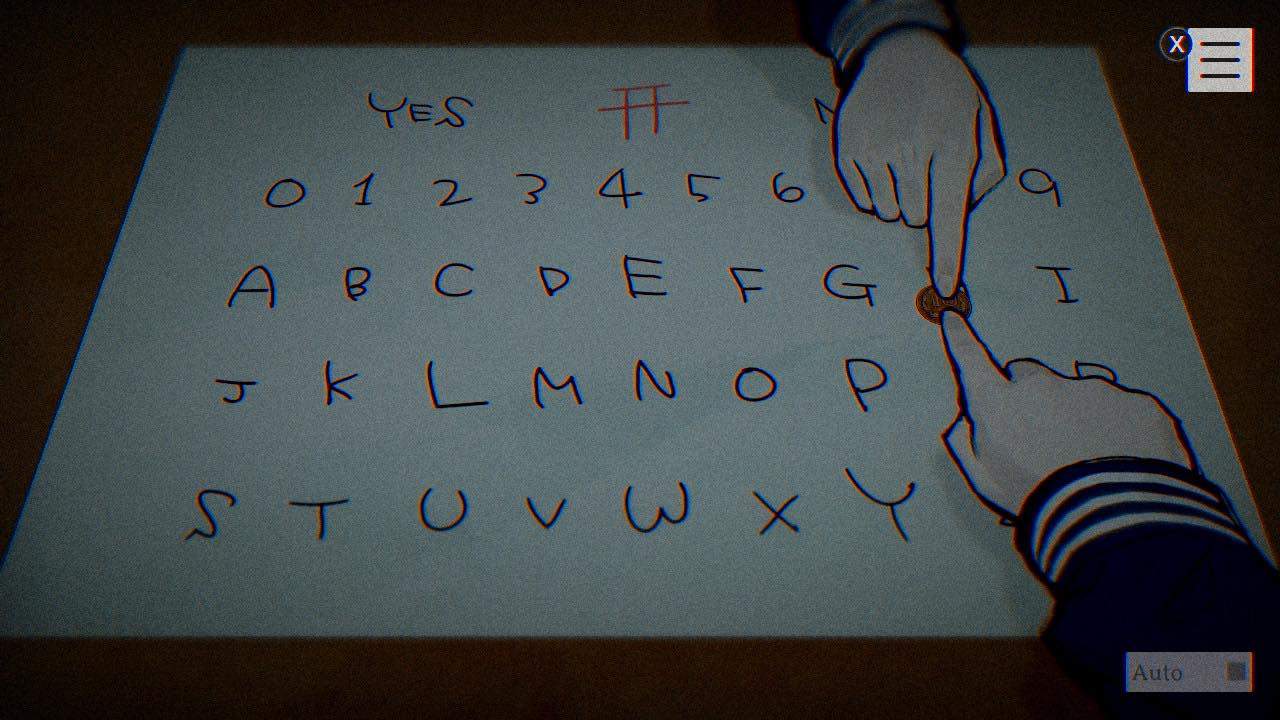
Often you’ll have to choose a single dialogue option more than once to get more information, rather than conveying it in one go. This isn’t a new issue in the visual novel genre and has popped up in greats such as the Ace Attorney series, but it’s still a marginal annoyance from time to time.
Investing in a showstopping late 20th Century Japan
The Showa period Japan is painted oh so beautifully in PARANORMASIGHT. Every single choice in characters and the environment design feels deliberate. Light shading makes up the gist of the characters and the world. However, the silhouette of a character or the creases on their clothes is imperfect, creating harsh lines and a rough sketch appearance. This is in careful contrast with the further detailed environments they’re found in. What this achieves is the characters popping out of the screen, demanding your attention and remaining memorable while that gorgeous, captivating urban Japanese scenery occurs around them.
Such an approach means expressions can be exaggerated to emphasise the horror and chilling vibes on offer. Characters’ eyes can bulge out in unnerving but hard to look away from ways. Smile lines and other wrinkles can be overzealous when one is expressing a look of surprise or dread, once more likening back to that Ito style of artwork.

Gen Kobayashi, one of The World Ends with You series’ key character artists is credited in the same role for PARANORMASIGHT. That pedigree shows. Each and every character is designed with fantastic and authentic detailing of their dress. My favourite of the bunch is Richter, the private investigator that is designed in a white suit and matching hat that looks like that of Michael Jackson’s Smooth Criminal get up. Just why does he look like this? Who knows! It certainly does however bring vibrancy to each and every scene he’s in and compliment his kooky and out-there personality.
Music and sound atmos also provide these positive effects. Hidenori Iwasaki, whose credits include Front Mission 4, FINAL FANTASY Crystal Chronicles Remastered (2020) and last year’s Stranger of Paradise: Final Fantasy Origin is the head composer here. Sharp and harsh piano notes make up for the dreadful moments where the paranormal appears, leaving players wincing. A soft and more whimsical acoustic guitar piece plays when you’re living out the middle of the day and it’s quieter, working the beat of the mystery.
PARANORMASIGHT is a game that by nature could very well go under many people’s radar. I hope that doesn’t end up being the case. Square Enix every so often puts out these daring and more experimental works that work far better than their big, over-ambitious titles that are chasing trends. More of this type of work. Please.
9
Amazing
Positive:
- Thrilling and bone-chilling story with many twists and turns
- Engaging and well distinguished characters and world
- Puzzles use an excellent rework of visual novel tropes and traditions
- Battle of the wits scenes between curse bearers is excellent source of tension
- Wonderful atmospheric music work
Negative:
- Occasional requirement of over-exhausting dialogue and interactive points to move on from a scene
PARANORMASIGHT: The Seven Mysteries of Honjo is a gripping page-turner of a visual novel. It occupied my brain so much that every second not playing felt like a second wasted. It felt like I was hit with so many fitting and bending twists I was second-guessing everything I once knew, always on my toes. Immensely powerful and engaging writing in-game is bolstered with memorable and distinguished characters. Those characters and the late 20th century Japan setting are incredibly realised; a feat only possible by the industry legends at the helm. In art, music and writing, players are in for a meaningful and unforgettable experience that’s a must-play for the genre. Better yet, it even has fun with the genre tropes and traditions, creating engaging puzzles and problem-solving throughout. If there’s one visual novel game you play this year, make it this one. You won’t regret it.
